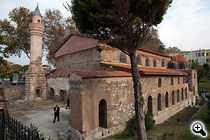
The 1700-year-old building was a church until 1331, when it was turned into a Muslim house of worship following the Ottoman conquest of the province. (Photo: Jonathan Lewis)
Muslim worshipers have recently returned to the former Byzantine church known as the Hagia Sophia in the lakeside town of Iznik. Like its famous Istanbul namesake, it had served for more than 80 years as a museum. (Photo: Jonathan Lewis)
In its 1,700-year-old history, Hagia Sophia in the northwestern town of Iznik has witnessed many turning points. In 787, as a Byzantine church, it housed the Second Council of Nicaea, which restored the veneration of icons to Christianity. After the Ottoman conquest of the area, Hagia Sophia in 1331 was turned into a mosque, only to be destroyed in 1922 by the Greek army during the Greco-Turkish War.
Then, this November 6, the building, a museum and popular Iznik tourist destination, underwent its latest transformation: It officially reopened as a mosque.
The first call to prayer had resounded from its minaret five days earlier, on the evening of November 1. With a new wooden floor, carpets and a sound system for the minaret, Hagia Sophia was opened to Muslim worshippers during Kurban Bayrami, the Festival of Sacrifice, a four-day Islamic holiday that commemorates Abraham’s willingness to sacrifice his son, Ishmael, at God’s command.
But a day after the holidays, the mosque remained half-empty during noon prayers. Hagia Sophia’s latest transformation has created controversy not only among archeologists, historians and politicians, but also among local residents.
“There are so many mosques in the city and around here,” said Irfan Karaman, who runs a small restaurant across from the Byzantine building. “In my opinion, it was utterly unnecessary to turn the Hagia Sophia into one as well.”
He claimed that many people in Iznik feel similarly. “Before it was seven lira (about $3.83) to enter,” Karaman added, laughing. “At least now it’s free. It looks like our religion is cheaper than yours!”
Historian and documentary filmmaker Ömer Tuncer, also an Iznik resident, agrees. “This is a question of respect. What would Muslims say if the Al-Aqsa Mosque [in Jerusalem] was turned into a church now? The Hagia Sophia in Iznik is an important symbol in Christian faith, a place of pilgrimage,” Tuncer said. “It is clear that a building like this needs to be protected as a museum.”
Acknowledgements of Turkey’s Islamic heritage and beliefs have become more frequent in recent years, but the conversion of Iznik’s Hagia Sofia does not appear to stem from any government policy by the ruling, Islamist-rooted Justice and Development Party. Although the changeover from a museum has sparked national debate, the decision is seen as locally rooted. Attendants at Hagia Sophia, however, declined to speak with EurasiaNet.org about the mosque opening.
Those siding with the conversion project argue that Hagia Sophia has never been a museum. “This historical building was used as a mosque for 680 years, and has been in disrepair ever since 1922,” Adnan Ertem, head of the central government’s Directorate of Religious Foundations, asserted to Turkish media. “To hear the Muslim call to prayer in this house of worship made us all happy.”
Apparently, the entrance fee charged to tourists in the past escaped the notice of Deputy Prime Minister Bülent Arinç, who also maintains that the building “was never a museum.”
“It is possible that it was used as a church in the past,” Arinç told Turkish media. “But ever since the conquest of Bursa [in 1326], it has been used as a mosque.”
However, both the Governorate of Bursa, the administrative district in which Iznik is located, and the Turkish Ministry of Culture and Tourism have listed and promoted the Iznik Hagia Sophia as a museum on their Turkish-language websites.
The explanation could lie in a red-tape loop-hole, Tuncer hypothesized. “Just as with the Hagia Sophia in Istanbul, there was never an official law to turn the Hagia Sophia in Iznik into a museum,” he commented. “That is why it is still listed as a mosque with the Directorate of Religious Foundations, but as a museum with the Ministry of Culture.”
After renovation of the building was finished in 2007, the Hagia Sophia was opened as a museum, and the local governorate placed a ticket booth at its entrance. Restaurant owner Karaman fears that the decision to turn the building now into an mosque will negatively impact the tourism sector, an important source of income for many Iznik residents.
Representatives of the Ministry of Culture were not available to comment about the changeover, but Tuncer asserts that “[i]t is up to them to veto this decision, and to protect buildings like this one.”
“When the church was turned into a mosque in 1331, it was a mere symbol of conquest, it happened in many cities,” he continued. “But in our times, this decision seems incomprehensible to me.”
Editor’s note:
Constanze Letsch is a freelance writer based in Istanbul.
via Turkey: Mystery Surrounds Decision to Turn Byzantine Church Museum into a Mosque | EurasiaNet.org.

Leave a Reply